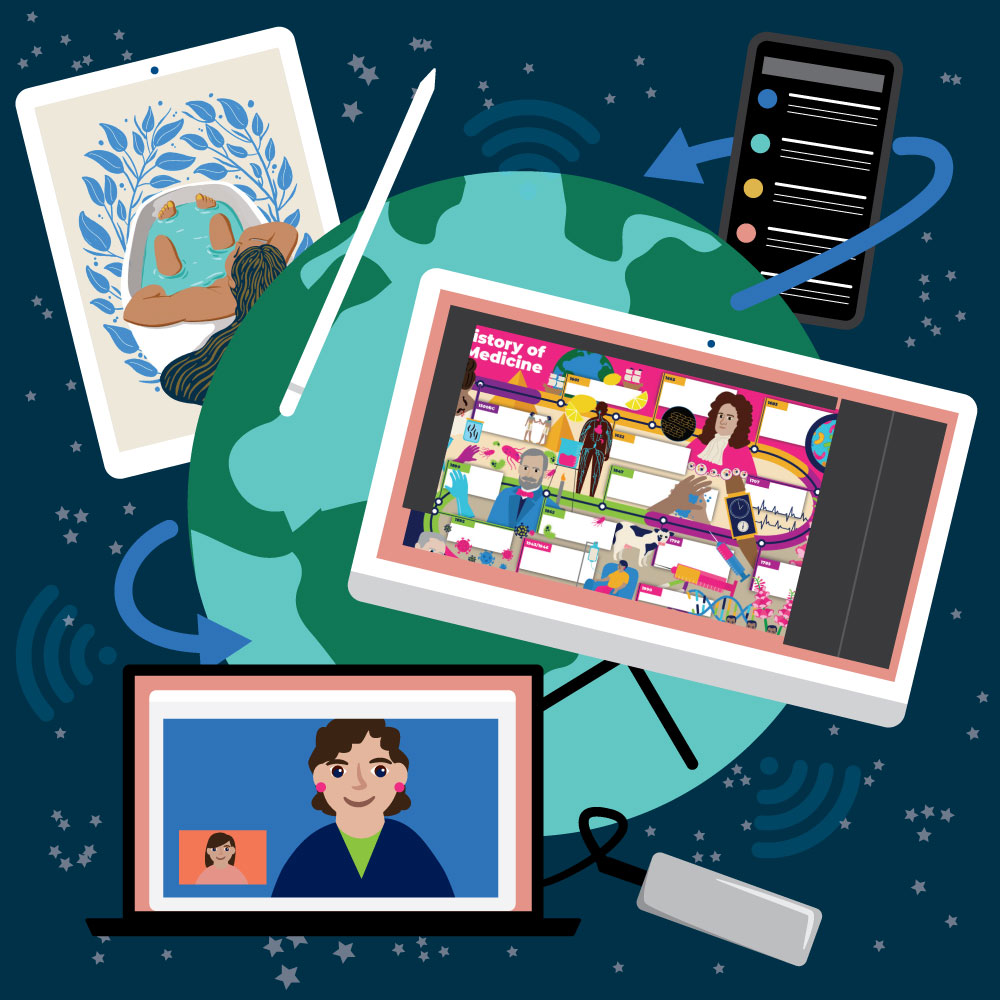
I’m gearing up for a two-month adventure to New Zealand with my partner. We have family there so it’s something we try to do every 2 to 3 years (at least in non-pandemic times!). As it’s a reasonably regular occurrence we’ve had to get good at working while we are away and learn to be digital nomads and how to do that in the most efficient way possible.
If you’re one of my clients, you might wonder how things will tick along while I’m away. And if you’re a fellow illustrator, you may be curious about taking your illustration studio on the road and becoming a digital nomad. Fear not; I’ve got a tried-and-tested plan that makes working from halfway across the world as smooth as from my studio at home.
Here’s how I make it happen
- Tech essentials: My iPad and Apple Pencil, my laptop, and an external hard drive are my go-to tools. These gadgets are packed into my carry-on and ensure that I can continue my work seamlessly, no matter where I am.
- Access anywhere: With Dropbox, all my work files are just a click away, meaning my Macbook mirrors exactly the setup I have with my iMac back in the UK. The external hard drive is my safety net, housing backups of all my work, just in case.
- Mini studio setup: As a seasoned digital nomad, there is a monitor waiting for us in New Zealand, so setting up a mini studio is a breeze. Plugging my laptop into the monitor transforms any space into my temporary workspace.
To My Valued Clients.
I want to reassure you that my time away from the UK won’t impact the quality or schedules of my work. My mini studio in New Zealand is tried and tested, and aside from the sunshine and the beach, it’s pretty much business as usual!
- Time zones, what time zones? Just like when I’m in the UK, I’m always reachable. Whether it’s via email or video chat, I’m here to answer any questions and provide updates on our ongoing projects. I’m pretty good at navigating time zones, so can manage deadlines and schedules, making sure that my temporary shift in geography is practically imperceptible in our workflow.
- Not my first rodeo Having done this many times before, I’ve fine-tuned my setup and workflow to ensure everything runs smoothly. You can rest assured that I’ve got a well-rehearsed plan in place and have everything I need to complete projects, sort estimates and polish proposals while I am away.
- A happy illustrator is a better illustrator It’s not just about maintaining the status quo; it’s about inspiration and recharging the creative battery. A change of scene sparks new insights, bringing fresh perspectives to your projects.
Tips for Fellow Illustrators and Digital Nomads.
If you’ve ever thought about taking your work on the road, here are a few tips based on my own experiences:
Invest in reliable gadgets
Ensure your tech tools are travel-friendly and reliable. The last thing you want is equipment failure when you’re miles away from home. Buy cases and sleeves for them and find a good carry-on bag with padded laptop-sized pockets and plenty of room for cables and chargers. Take extras of accessories like screen protectors or Apple Pencil tips, it might not be possible to get hold of them in a hurry where you are.
Cloud storage is your friend
Use cloud storage services such as Dropbox. They’re a game changer for remote access and provide a secure backup for your work. Also, make sure you can access your accounting and invoicing systems on the go. You don’t want to have to wait until you get home to send out those invoices! (See my post about the software I use to power my business here)
Create a portable workspace
If you find a laptop screen too limiting, remember that your iPad can double as a second screen with Apple’s Sidecar feature. It’s a game-changer for expanding your digital canvas without packing extra gear. And if you need something bigger, then look into computer equipment rental companies. Hiring a monitor is a fantastic option to consider if you plan to be in one place for a little while.
Test your setup
Before you travel, do a trial run. Ensure everything connects properly and you have all the necessary cables and accessories. It’s also worth trialling your set-up in the field away from your home Wi-Fi and internet access to iron out any bugs, perhaps from a friend’s house, a local cafe or a hotel.
Stay connected
Pick up a local pay-as-you-go SIM card with a decent data allowance for your phone. This is a lifeline for on-the-go internet access which you can tether all your devices to. Tap into the Wi-Fi where you’re staying for bulkier tasks like uploading final designs or video calls. Keep your eyes peeled for cafes and libraries offering free Wi-Fi, these spots are brilliant for the digital nomad.
Ensure insurance
Make sure all your equipment is covered by your home, business, or travel insurance and that you have valued them correctly. Your tools are your livelihood; safeguarding them ensures your adventure is memorable for the right reasons!
And finally, remember to have fun: For all this talk about taking your studio with you, don’t forget to leave it regularly. Go and see the place you’re visiting. You are on holiday as well, take time out, go see stuff, hang out with people, let inspiration strike, take an afternoon nap in the sunshine, go to that cool cocktail place. All of these will make you and your work better!
Juggling travel and deadlines as a digital nomad
Navigating the balance between work and travel as a digital nomad can be challenging, especially when it comes to meeting deadlines while on the move. To help you master this, I’ve compiled some practical strategies that have been invaluable during my own trips.
Pre-plan work around your travel
Before setting off on your travels, take a look at your itinerary and identify periods where you’ll be less likely to work, such as during long flights or the days before or after you arrive somewhere new. Plan your deadlines and work schedule around these times. This means getting ahead on work before these ‘low productivity’ periods and setting realistic deadlines that factor in your travel plans.
Leverage time zones to your advantage
Travelling often means crossing into different time zones, which you can turn into a strategic advantage. If you’re ahead of your client’s time zone, you can work while they’re offline, allowing for uninterrupted productivity. If you are behind their timezone then you start your day when your clients are partway through theirs. This makes it easy to address any urgent tasks or feedback they’ve sent.
Set clear work Boundaries
When traveling, it can be easy to lose track of a regular work routine. This makes is even more important to set specific work hours and stick to them. This might mean working early mornings or late evenings so you have the day to enjoy the place you are visiting. Developing a routine also signals to clients when you’re available, making communication smoother.
So there you have it, a little insight into how I make working abroad work for me. It’s all about being prepared and having a solid plan in place.
To my clients, thank you for your continued trust and support, I might be swapping my usual cuppa for a Kiwi flat white, but my work continues in more or less the same way. I promise not to mention the weather too much!
And to my fellow illustrators, I hope this post inspires you to become a digital nomad and explore the world without missing a beat.
Contact me if you’d like to discuss how I can help with your next illustration project.

